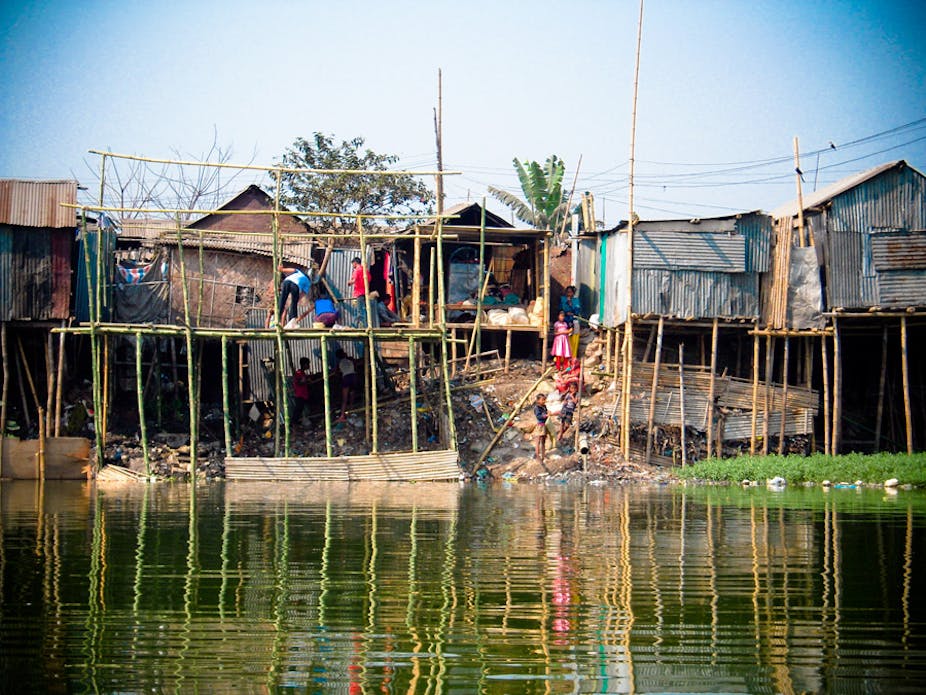How far can journalists and aid agencies stretch a story for a good cause? If you know it will be true soon, can you say it is true now in order to help poor people and countries? Can you help to stave off a slow onset disaster by pretending it is already happening?
This is the problem for Bangladesh. Oxfam says “every day, 4,000 Bangladeshis are moving to cities in search of a safer life, away from the challenges of increasingly extreme weather”. Christian Aid and the Guardian both write of climate change refugees going to Dhaka. Even the UK Department for International Development (DfID says Bangladesh is “already experiencing the effects of climate change”. But this is not exactly true.
For decades, floods and cyclones have destroyed farms and livelihoods, and people have fled to the cities. What is new is that Bangladesh is now one of the most vulnerable countries in the world to climate change. All the predictions are that climate change will make the floods worse and the cyclones stronger and more devastating. If global warming is not curbed, there will be tens of millions more people moving to the cities, and these will be climate change refugees.
But it is not happening yet, and as we show in a new book, Bangladesh Confronts Climate Change, the country is not a helpless victim. For two decades, it has been campaigning to limit global warming, and has been building defences against climate change. It is a poor country, but three quarters of spending on climate comes from the national budget and not from donors.
Climate change is rightly a priority issue. Aid agencies want to raise money by saying they are helping climate change victims. Journalists want to write about the effects of climate change. Bangladesh needs the money. It is tempting to collude and say ordinary environmental refugees are “climate change refugees” – after all, their children will be, in a decade or two.
But what is actually happening is different and is linked to Bangladesh’s unique geographic position. Bangladesh is a densely populated country which feeds itself because it is on a rich delta. But its position means it is subject to destructive cyclones coming up the Bay of Bengal as well as huge and dramatic floods caused by monsoon rains and water pouring down from the Himalayas. For decades, there have been environmental refugees, forced to the cities by floods and cyclones. But they are not climate change refugees.
The Bangladesh environment is hugely variable. The worst flood in a century was in 1998 when 68% of the country was flooded, but that flood came only four years after the driest year, 1994, when a mere 0.2% of Bangladesh was flooded. The last maximum category cyclone was in 2007.
Scientists can see temperatures slowly increasing and sea levels rising, but the annual changes are too small to notice. So no Bangladesh disaster can be blamed on climate change – yet. There are no climate change refugees – yet. But greenhouse gases are building up and the global temperature is rising. Himalayan glaciers will start to melt, making floods worse; the temperature of the Bay of Bengal is rising and cyclones will be more powerful and destructive.

Christian Aid and the Guardian both cite people who have moved from coastal areas to Dhaka, the capital and the largest city in Bangladesh. But they were pushed out by cyclones and an aid project that went wrong, not by climate change. With early warning systems and shelters, Bangladesh has hugely cut the death and injury rate from cyclones but property damage is still severe, and some people choose to migrate to cities and start again there.
Another group of refugees they cited were displaced by a misguided aid project to build dykes and create Dutch style polders which did not take account of Bangladesh’s massive monsoon rainfall, which flooded and then waterlogged the land in the polders, so it could not be farmed, forcing thousands to move in recent years.
These groups could be called “environmental refugees”, so is any harm done in calling them “climate change refugees”? One of the problems in identifying them with the latter is that it ignores the way these stories have another side, one that involves actors rather than victims, who are able to do things to help themselves.
Locally-designed cyclone protection and support systems do not just save lives, but also help people remain after a disaster and rebuild their lives. Bangladeshi communities and engineers have developed ways of using the sediment flowing into the delta from the mountains to reverse the waterlogging, and even to raise the land to match sea level rises.
When it comes to climate change, Bangladeshis will also be taking a key role in annual climate change negotiations this year in Marrakech. These are the Bangladeshis on the frontline of climate change, who are fighting now to push us to reduce greenhouse gas emissions, and who are working in Bangladesh to adapt to what they know is coming.
Perhaps aid agencies and journalists can best help Bangladesh by telling the stories of Bangladeshi climate change heroes trying to prevent people becoming climate change refugees, instead of only telling stories of helpless victims who could be labelled climate change refugees.

